Managerial Finance - Task 2: Project Evaluation and Analysis Report
VerifiedAdded on 2021/06/15
|8
|753
|24
Report
AI Summary
This report provides a detailed evaluation of two projects using key financial metrics. It begins by calculating the Net Present Value (NPV), Internal Rate of Return (IRR), Profitability Index (PI), and Payback Period for an initial project, determining its financial viability based on these criteria. The report then compares two additional projects, analyzing their NPV, IRR, and payback periods to determine which project is more financially sound and should be selected, considering the constraints of a payback period. The analysis includes comprehensive tables illustrating the calculations and a conclusion that recommends the most viable project. The report also references relevant academic sources to support the analysis.
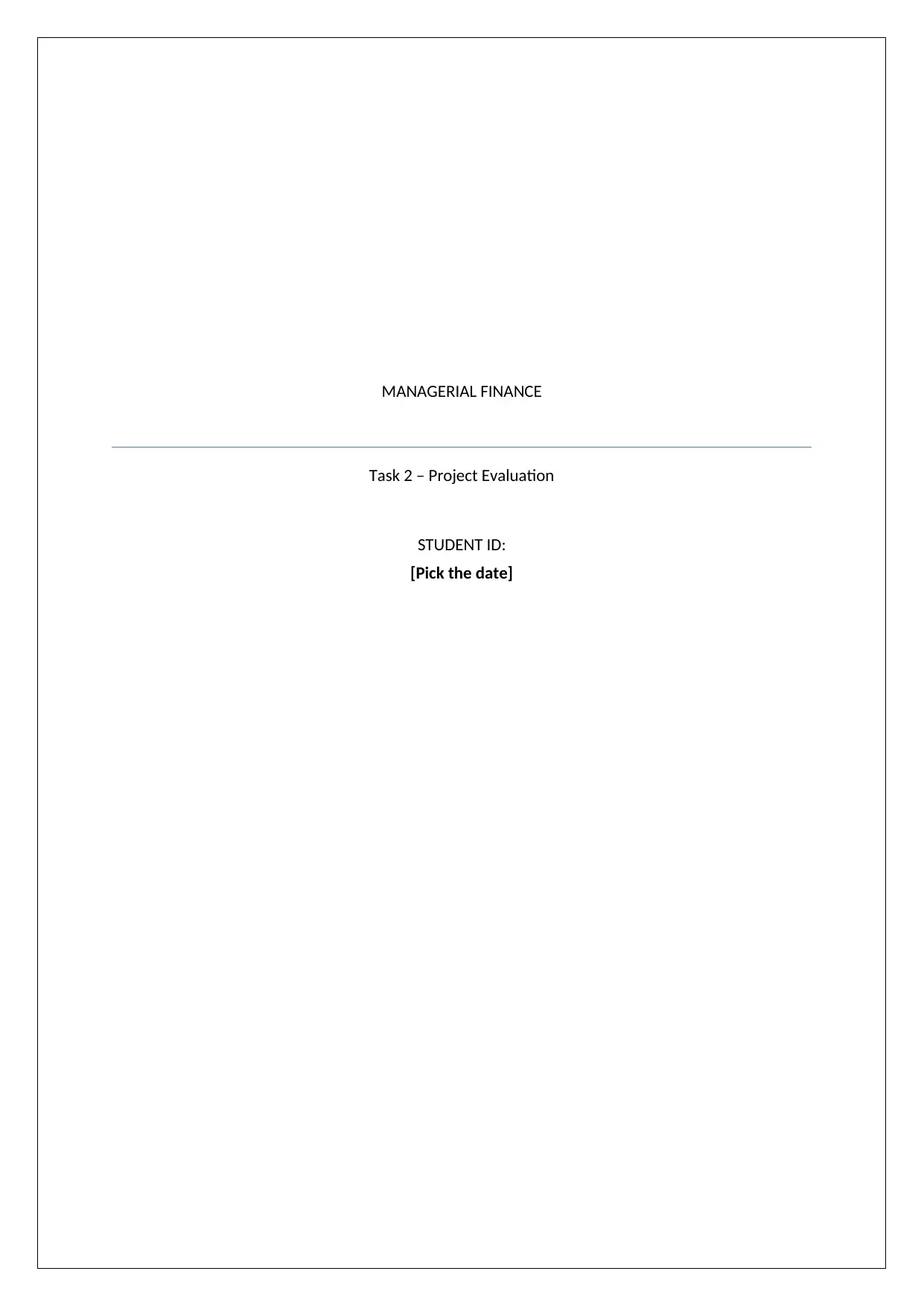
MANAGERIAL FINANCE
Task 2 – Project Evaluation
STUDENT ID:
[Pick the date]
Task 2 – Project Evaluation
STUDENT ID:
[Pick the date]
Paraphrase This Document
Need a fresh take? Get an instant paraphrase of this document with our AI Paraphraser
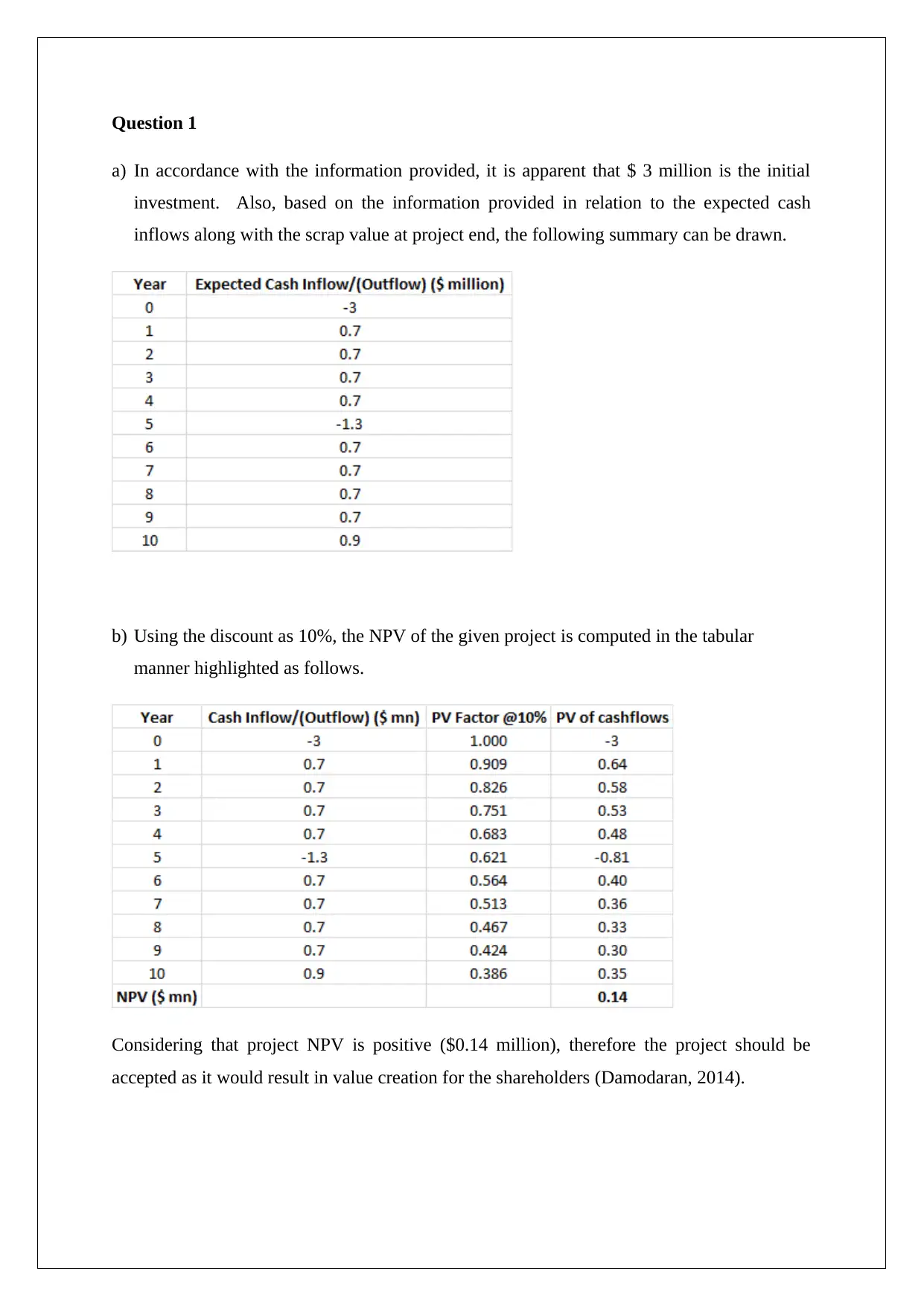
Question 1
a) In accordance with the information provided, it is apparent that $ 3 million is the initial
investment. Also, based on the information provided in relation to the expected cash
inflows along with the scrap value at project end, the following summary can be drawn.
b) Using the discount as 10%, the NPV of the given project is computed in the tabular
manner highlighted as follows.
Considering that project NPV is positive ($0.14 million), therefore the project should be
accepted as it would result in value creation for the shareholders (Damodaran, 2014).
a) In accordance with the information provided, it is apparent that $ 3 million is the initial
investment. Also, based on the information provided in relation to the expected cash
inflows along with the scrap value at project end, the following summary can be drawn.
b) Using the discount as 10%, the NPV of the given project is computed in the tabular
manner highlighted as follows.
Considering that project NPV is positive ($0.14 million), therefore the project should be
accepted as it would result in value creation for the shareholders (Damodaran, 2014).
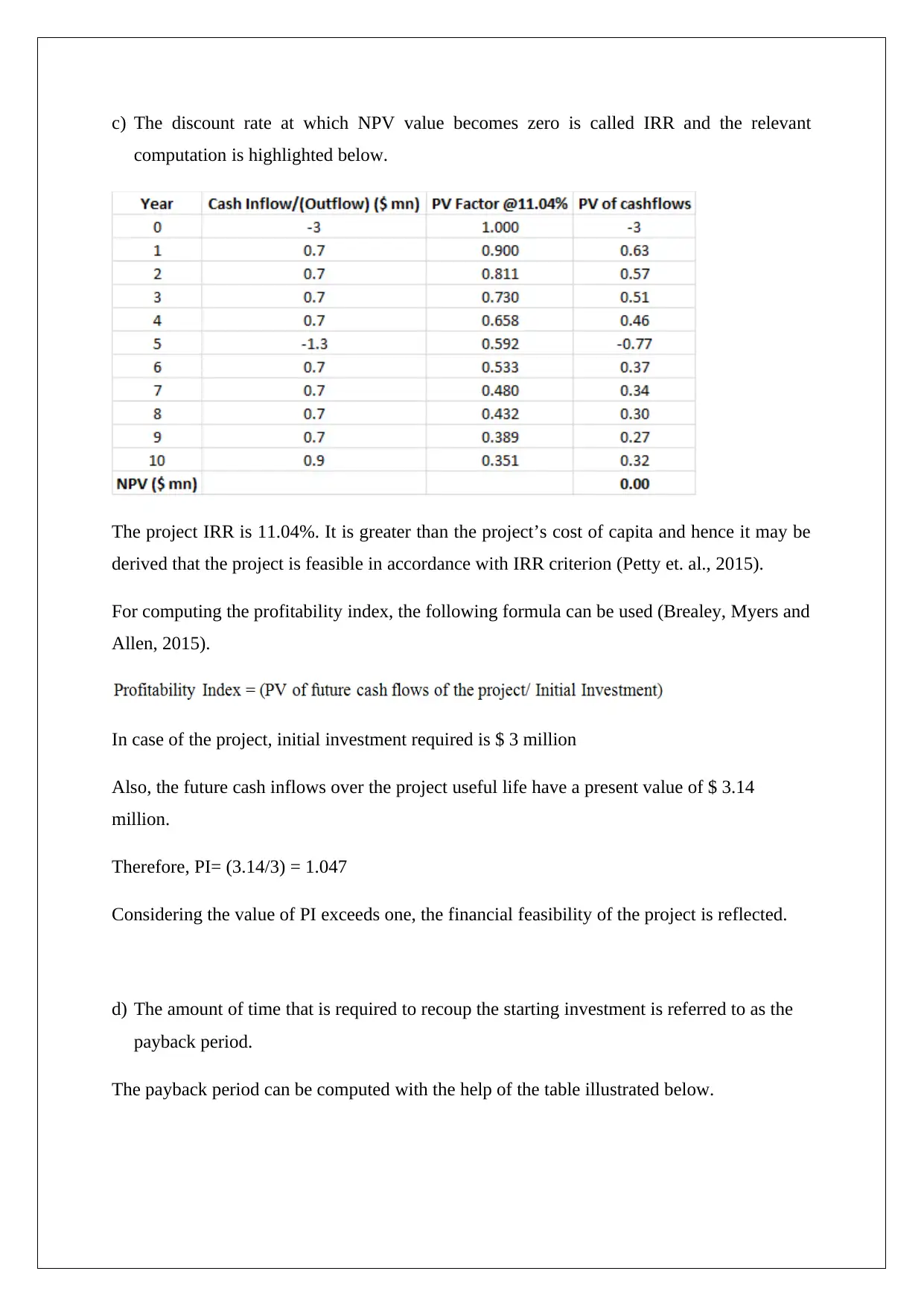
c) The discount rate at which NPV value becomes zero is called IRR and the relevant
computation is highlighted below.
The project IRR is 11.04%. It is greater than the project’s cost of capita and hence it may be
derived that the project is feasible in accordance with IRR criterion (Petty et. al., 2015).
For computing the profitability index, the following formula can be used (Brealey, Myers and
Allen, 2015).
In case of the project, initial investment required is $ 3 million
Also, the future cash inflows over the project useful life have a present value of $ 3.14
million.
Therefore, PI= (3.14/3) = 1.047
Considering the value of PI exceeds one, the financial feasibility of the project is reflected.
d) The amount of time that is required to recoup the starting investment is referred to as the
payback period.
The payback period can be computed with the help of the table illustrated below.
computation is highlighted below.
The project IRR is 11.04%. It is greater than the project’s cost of capita and hence it may be
derived that the project is feasible in accordance with IRR criterion (Petty et. al., 2015).
For computing the profitability index, the following formula can be used (Brealey, Myers and
Allen, 2015).
In case of the project, initial investment required is $ 3 million
Also, the future cash inflows over the project useful life have a present value of $ 3.14
million.
Therefore, PI= (3.14/3) = 1.047
Considering the value of PI exceeds one, the financial feasibility of the project is reflected.
d) The amount of time that is required to recoup the starting investment is referred to as the
payback period.
The payback period can be computed with the help of the table illustrated below.
⊘ This is a preview!⊘
Do you want full access?
Subscribe today to unlock all pages.

Trusted by 1+ million students worldwide
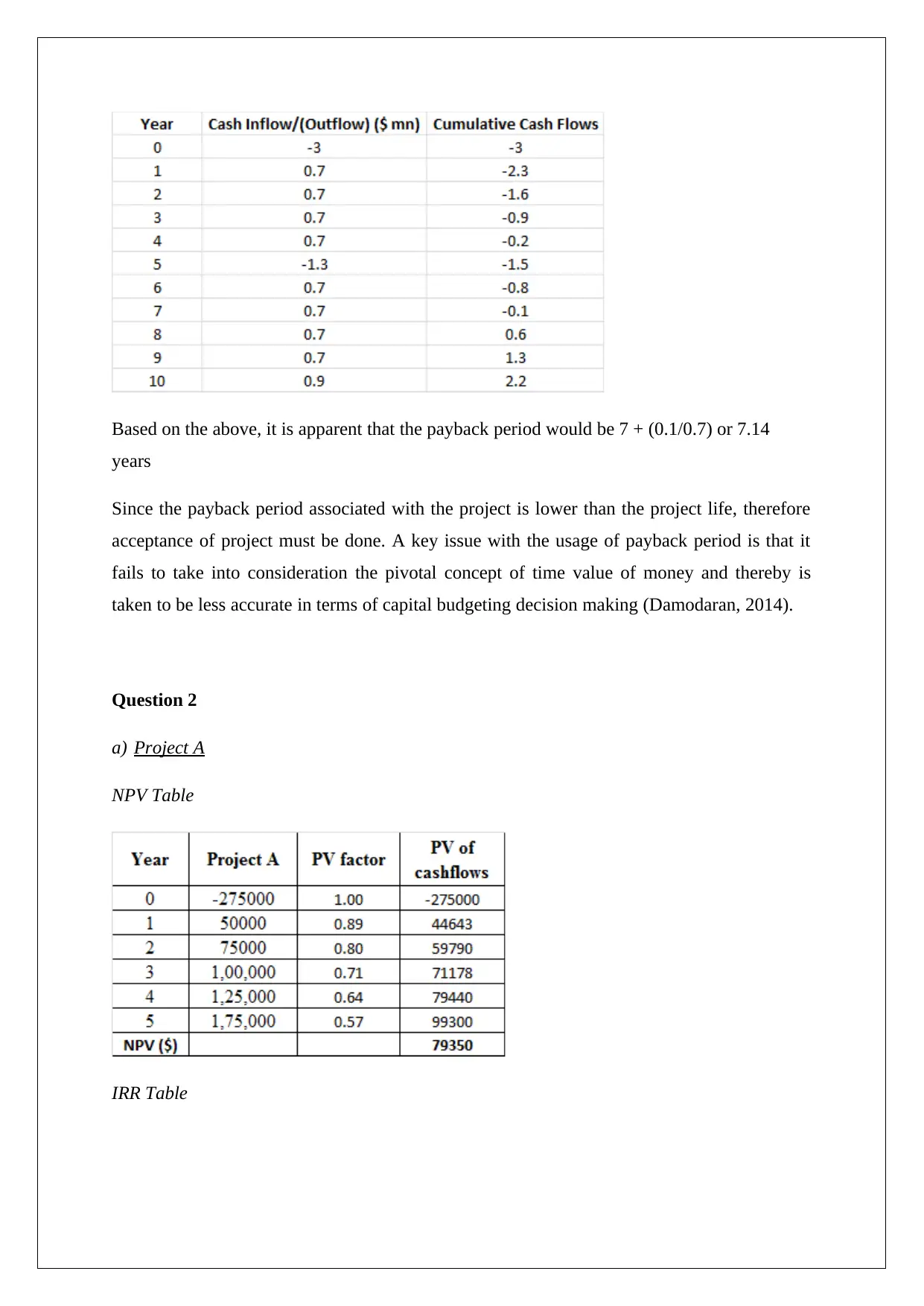
Based on the above, it is apparent that the payback period would be 7 + (0.1/0.7) or 7.14
years
Since the payback period associated with the project is lower than the project life, therefore
acceptance of project must be done. A key issue with the usage of payback period is that it
fails to take into consideration the pivotal concept of time value of money and thereby is
taken to be less accurate in terms of capital budgeting decision making (Damodaran, 2014).
Question 2
a) Project A
NPV Table
IRR Table
years
Since the payback period associated with the project is lower than the project life, therefore
acceptance of project must be done. A key issue with the usage of payback period is that it
fails to take into consideration the pivotal concept of time value of money and thereby is
taken to be less accurate in terms of capital budgeting decision making (Damodaran, 2014).
Question 2
a) Project A
NPV Table
IRR Table
Paraphrase This Document
Need a fresh take? Get an instant paraphrase of this document with our AI Paraphraser
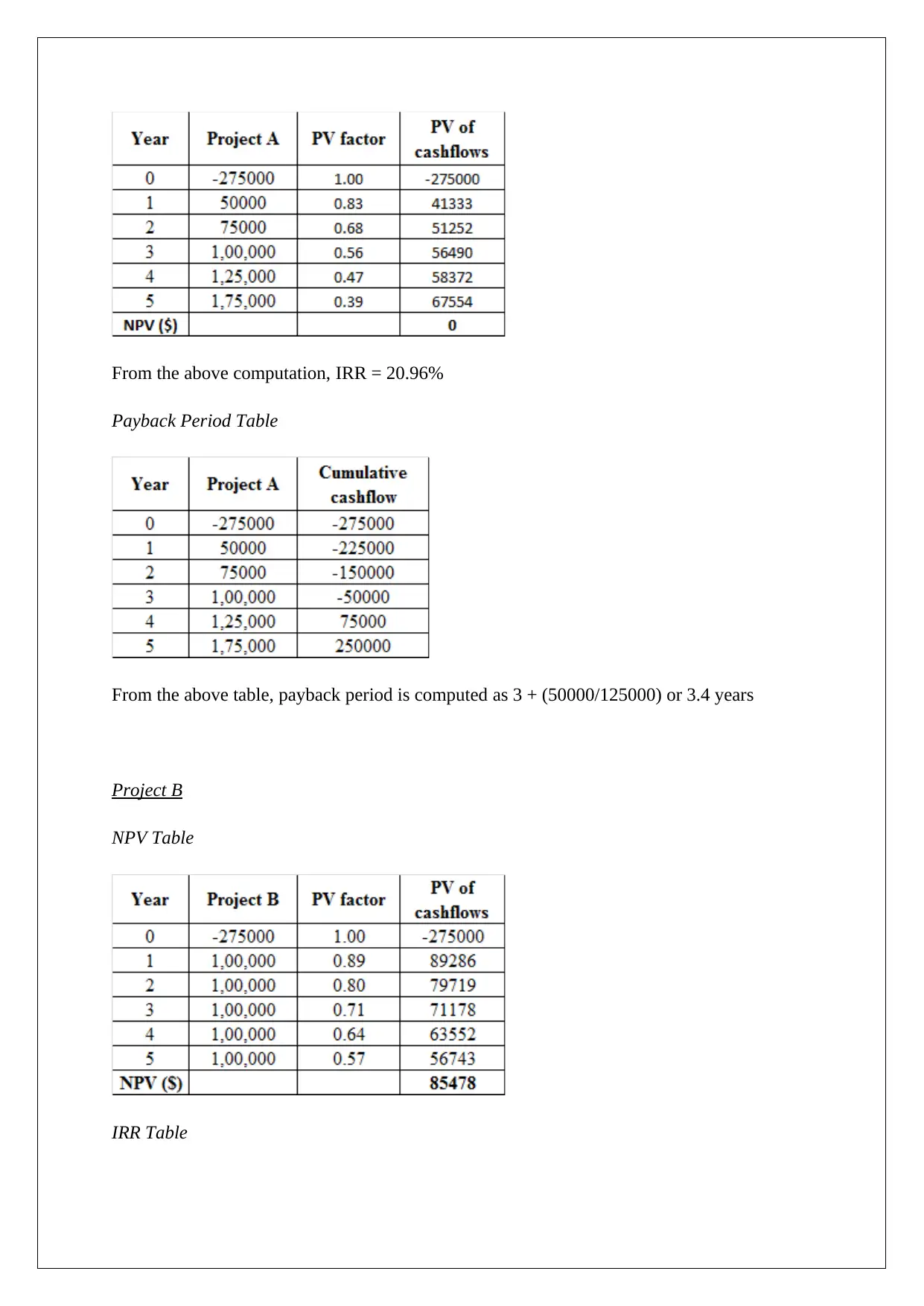
From the above computation, IRR = 20.96%
Payback Period Table
From the above table, payback period is computed as 3 + (50000/125000) or 3.4 years
Project B
NPV Table
IRR Table
Payback Period Table
From the above table, payback period is computed as 3 + (50000/125000) or 3.4 years
Project B
NPV Table
IRR Table
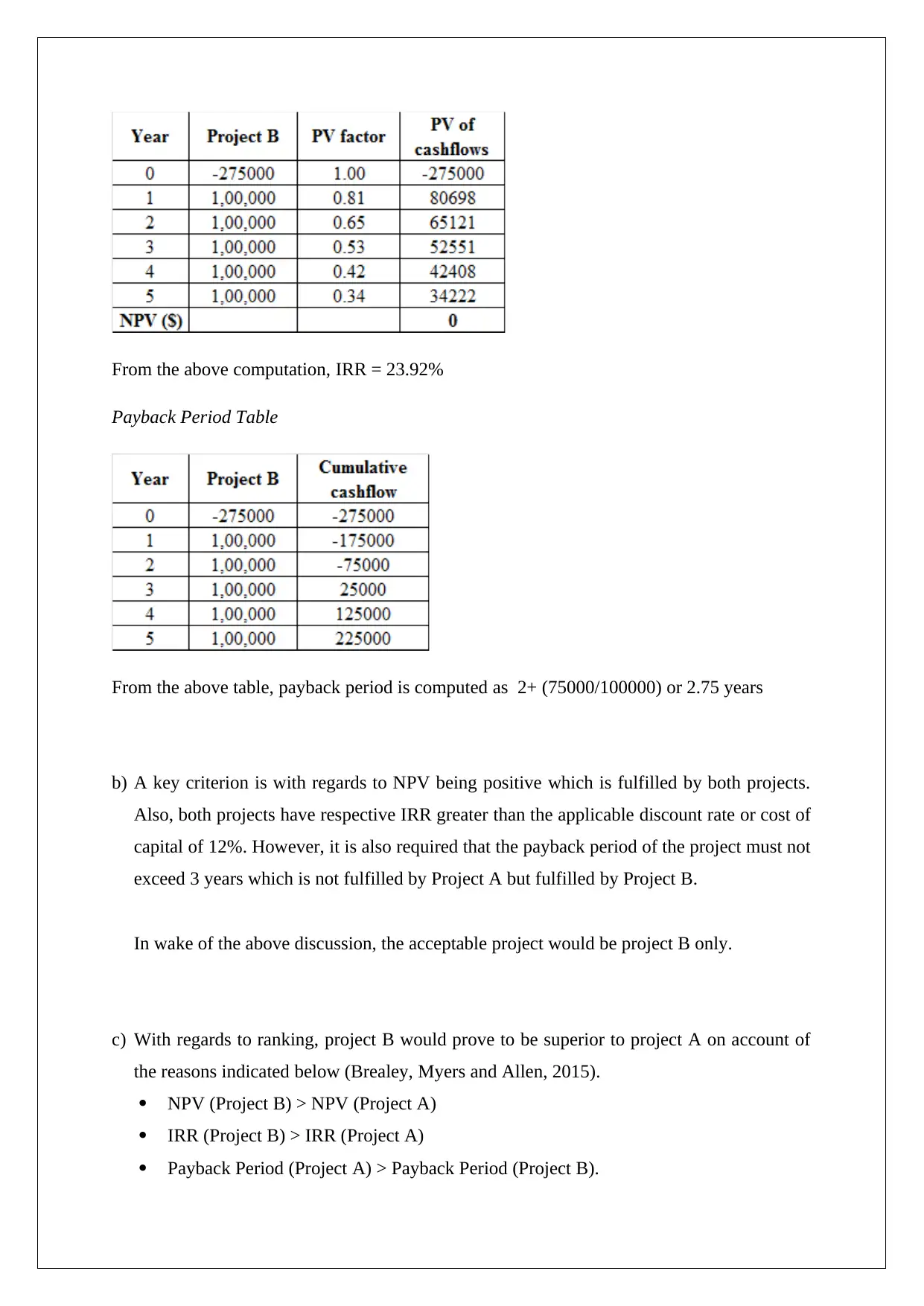
From the above computation, IRR = 23.92%
Payback Period Table
From the above table, payback period is computed as 2+ (75000/100000) or 2.75 years
b) A key criterion is with regards to NPV being positive which is fulfilled by both projects.
Also, both projects have respective IRR greater than the applicable discount rate or cost of
capital of 12%. However, it is also required that the payback period of the project must not
exceed 3 years which is not fulfilled by Project A but fulfilled by Project B.
In wake of the above discussion, the acceptable project would be project B only.
c) With regards to ranking, project B would prove to be superior to project A on account of
the reasons indicated below (Brealey, Myers and Allen, 2015).
NPV (Project B) > NPV (Project A)
IRR (Project B) > IRR (Project A)
Payback Period (Project A) > Payback Period (Project B).
Payback Period Table
From the above table, payback period is computed as 2+ (75000/100000) or 2.75 years
b) A key criterion is with regards to NPV being positive which is fulfilled by both projects.
Also, both projects have respective IRR greater than the applicable discount rate or cost of
capital of 12%. However, it is also required that the payback period of the project must not
exceed 3 years which is not fulfilled by Project A but fulfilled by Project B.
In wake of the above discussion, the acceptable project would be project B only.
c) With regards to ranking, project B would prove to be superior to project A on account of
the reasons indicated below (Brealey, Myers and Allen, 2015).
NPV (Project B) > NPV (Project A)
IRR (Project B) > IRR (Project A)
Payback Period (Project A) > Payback Period (Project B).
⊘ This is a preview!⊘
Do you want full access?
Subscribe today to unlock all pages.

Trusted by 1+ million students worldwide

Therefore, if only one project could be selected, it has to be project B and not project A.
Paraphrase This Document
Need a fresh take? Get an instant paraphrase of this document with our AI Paraphraser
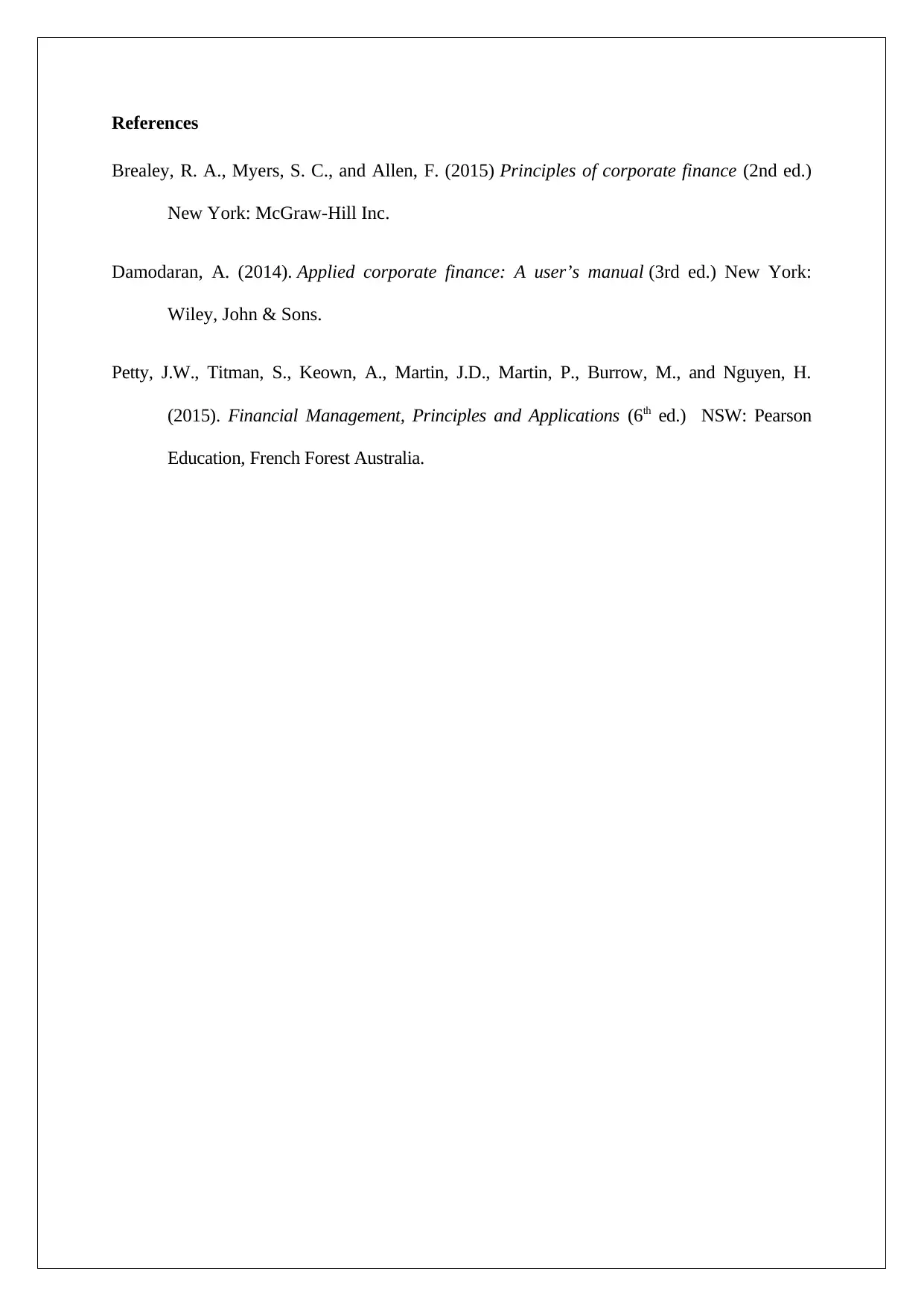
References
Brealey, R. A., Myers, S. C., and Allen, F. (2015) Principles of corporate finance (2nd ed.)
New York: McGraw-Hill Inc.
Damodaran, A. (2014). Applied corporate finance: A user’s manual (3rd ed.) New York:
Wiley, John & Sons.
Petty, J.W., Titman, S., Keown, A., Martin, J.D., Martin, P., Burrow, M., and Nguyen, H.
(2015). Financial Management, Principles and Applications (6th ed.) NSW: Pearson
Education, French Forest Australia.
Brealey, R. A., Myers, S. C., and Allen, F. (2015) Principles of corporate finance (2nd ed.)
New York: McGraw-Hill Inc.
Damodaran, A. (2014). Applied corporate finance: A user’s manual (3rd ed.) New York:
Wiley, John & Sons.
Petty, J.W., Titman, S., Keown, A., Martin, J.D., Martin, P., Burrow, M., and Nguyen, H.
(2015). Financial Management, Principles and Applications (6th ed.) NSW: Pearson
Education, French Forest Australia.
1 out of 8
Related Documents
Your All-in-One AI-Powered Toolkit for Academic Success.
+13062052269
info@desklib.com
Available 24*7 on WhatsApp / Email
![[object Object]](/_next/static/media/star-bottom.7253800d.svg)
Unlock your academic potential
Copyright © 2020–2025 A2Z Services. All Rights Reserved. Developed and managed by ZUCOL.




